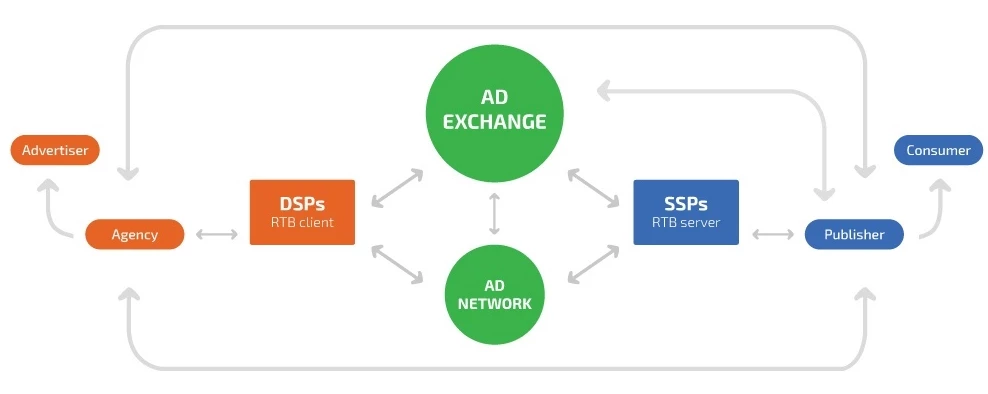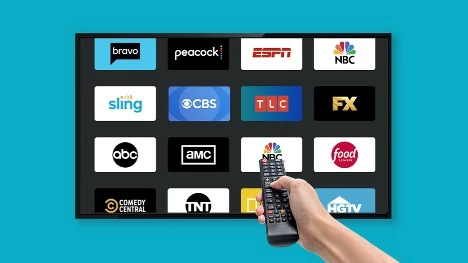In the ever-evolving digital advertising landscape, the term Programmatic Advertising may raise many questions for marketers. Although programmatic advertising has existed for 20 years, advancements in advertising technology have allowed this method to take off in the last five years.
Programmatic advertising is a digital advertising practice that uses AdTech software to automate the purchase, sale, delivery, and measurement of digital ads. In this automated process, digital ads are served across sites and apps, capable of reaching users across all devices, including TV, mobile, desktop, and even connected home devices such as Sonos speakers. For advertisers, programmatic takes the guesswork out of “where” their audience can be reached and allows for greater focus on the “who,” ensuring the ad is shown to the right people at the right place and time.
4 Variations of Programmatic Advertising
Programmatic advertising first began using the practice of Real-Time Bidding (RTB) on the Open Marketplace. Since then, it has evolved to present more opportunities to access a wide variety of placements. These include access to Private Marketplace (PMP) Deals, Preferred Deals, and Programmatic Guaranteed deals. Each type has unique features and benefits.
- RTB (Real Time Bidding) allows marketers to set up their ads to be part of an instant auction triggered when impressions are available. Based on the targeting and bid strategy, the ad is shown on the publisher’s site if the bid is higher than that of other ads bidding on that impression. Programmatic allows advertisers to automate the bid process to publish within the most relevant ad inventory at the exact moment their target user can be reached. RTB applies to Open Marketplace and privately owned inventory accessed programmatically.
- PMP, or Private Marketplace, is an invitation-only bidding opportunity granted from publishers to specific advertisers. PMPs allow the same automated buying within a specific privately owned ad environment. Some DSPs have preemptively made a large selection of privately owned inventory available to all advertisers. There are also cases where PMP deals outside of what is available through the DSP are set up when there is an opportunity to improve campaign performance or access more exclusive inventory.
- Preferred Deals, also known as Spot Buying or Non-Guaranteed, are less common than RTB and PMP. With Preferred Deals, you may have an opportunity to bid on a negotiated price, but it’s optional based on when ad inventory may become available. There are no guarantees, and you are not required to make the purchase.
- Programmatic Guaranteed, unlike Preferred Deals, provides guaranteed ad space from the publisher based on pre-determined pricing and the agreed-upon inventory. There is no auction bidding with this type of programmatic ad buy.
How Does Programmatic Work?

Media buyers and marketers rely on various platforms and tools to manage their programmatic advertising activations. The primary platforms involved are Supply-Side or Sell-Side Platforms (SSP), Demand-Side Platforms (DSP), and Ad Exchanges. Advanced algorithms, Artificial Intelligence, and Machine Learning power each platform.
- SSPs—Supply-side platform technology allows digital media publishers to sell ad inventory programmatically. When DSPs (see below) submit bids to an SSP, the SSP selects the ad with the highest bid to be displayed on the publisher’s inventory. DSPs will apply pre-bid solutions to ensure ads are only entered into auctions where the impression meets specified conditions for effective delivery.
A few common SSP platforms are Google Ad Manager, Google Ad Exchange, Pubmatic, Xandr, Sharethrough and Magnite.
- DSPs—Demand-side platforms are used by advertisers to access ad inventory, manage audience data, and set predetermined delivery controls. DSPs submit bids to SSPs to be entered into an RTB auction.
DSP software technology automates buying and selling digital advertising, allowing advertisers to quickly and intuitively manage programmatic campaigns. Leading DSPs, such as The Trade Desk, leverage AI to automatically adjust bid strategy to improve campaign performance on the fly.
Within the DSP, all audience and delivery controls are set, including budget, bids, creative, and KPI goals. Advertisers may evaluate different DSPs to determine which makes the most sense based on campaign goals. Some DSPs may provide more seamless access to exclusive inventory, while others may work best to access a particular media space (such as Google’s DV360 to access YouTube programmatically).
Examples of DSPs are The Trade Desk, Amazon, Google’s DV360, MediaMath, and StackAdapt.
Note: Vision Media is partnered with The Trade Desk, which has been named the leading global DSP for its unique value and cutting-edge advertising technologies.
- Ad Exchanges – These are marketplaces for ad impressions. Advertisers and publishers use these to buy and sell inventory using real-time bidding to bid on the available ad space. Ad exchanges can connect to SSPs and DSPs to efficiently automate the ad buying and selling process.
Some SSPs are also DSPs, and some are also Ad Exchanges. Examples of these platforms include Pubmatic, OpenX, Google Ad Exchange, Verizon Media, and many more. These platforms play a crucial role in the programmatic advertising ecosystem, connecting advertisers and publishers to buy and sell ad inventory.
Programmatic versus Display Advertising
A question often asked is - what is the difference between programmatic and display advertising? Display ads are simply one media type that can be purchased programmatically. The ad format includes an image, text, and a web link. While display ads can be bought directly from a publisher’s site, they can be shown to the right person at the right time across many sites when activated programmatically. Programmatic advertising is how ads are bought, while display ads are the format and placement of the ad.
The format of the ad determines the media type, which then determines which placements the ad can bid on. Ad media types that can be activated programmatically include:
- Display
- Native Display
- Video - Online Video and PreRoll
- Audio – served alongside streaming audio content
- CTV/OTT

What is CTV/OTT?
One of programmatic's most enticing features is the accessibility of streaming TV inventory, referred to as CTV and OTT.
- Connected TV (CTV) refers to any television that is connected to the internet and used to stream video. This includes smart TVs and TVs connected through external devices like TV sticks and gaming consoles. While smart TVs can access the internet directly, devices such as Amazon Firestick, Roku, Xbox, and the like are also used to stream video content on a TV.
- Over-the-top (OTT) is similar to CTV in that ads are displayed alongside streaming video content but are delivered across all devices, such as mobile, desktop, and tablets. For example, if someone is served an ad while watching Hulu on their phone, this is considered an OTT ad environment.
CTV and OTT deliver streaming video inventory across ad-supported platforms such as Hulu, Peacock, Discovery+, Fubo, Freevee, Prime—the list goes on. When streaming video is accessed programmatically, advertisers can leverage precise targeting and measurement benefits unavailable in traditional TV buys.
As new ad-supported streaming platforms increase, cable bundle purchases remain on the decline. According to The 2024 Connected TV Report from The Trade Desk, advertisers favored CTV/OTT over traditional for easier campaign optimization, scalability, improved return on ad spend (ROAS), and the ability to control ad frequency.
Benefits of Programmatic Advertising
Programmatic advertising offers precise audience targeting through third-party and first-party data, efficient bidding techniques, scalable inventory with high levels of control, performance measurement and attribution, and AI technology built to help advertisers exceed their campaign goals. These benefits can significantly enhance the effectiveness and reach of your digital campaigns.
Although programmatic advertising functions in a complicated ecosystem of data, AdTech, and AI, its primary benefit is simple—it allows advertisers to reach their audiences wherever they are. It enables viewers to see more of what is relevant to them rather than being inundated with irrelevant ads.
Digital advertising also funds the Internet, allowing us to engage with free content. Programmatic digital advertising helps support that opportunity.
Programmatic Challenges
With the good comes the not-so-good in the form of ad fraud, a deep AdTech stack that increases costs and diminishes value, and challenges around transparency and attribution.
In addition, it was found that overarching ID solutions may only be accessible for up to 10% of users. Accuracy depends on verification processes, consumer consent, and advertisers having first-party data. While challenges persist, programmatic professionals and industry-leading partners continually work to mitigate these risks, protecting campaign integrity and performance.
As with any marketing initiative, testing is critical. Each advertiser has different goals, budgets, audience targets, and resources. Now that you better understand programmatic advertising, how the process works, and the benefits and challenges, you can make a more informed decision about future campaigns and be primed for your next conversation with your media partners.
If you would like our perspective, we are always happy to speak with you and provide an audit of your media plan to ensure you are getting the highest value for your budget. Let’s Connect.
Additional Sources –
https://advertising.amazon.com/blog/programmatic-advertising
https://www.searchenginejournal.com/what-is-programmatic-advertising-how-does-it-work
https://www.linkedin.com/pulse/programmatic-advertising-adtech-why-you-should-them-sydney-slayden
https://mountain.com/blog/connected-tv-advertising
https://www.thetradedesk.com/us/2024-ctv-report
Main Image source: pexels-mikael-blomkvist-6376260 team working on ad spend




